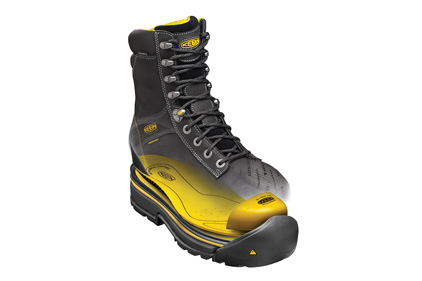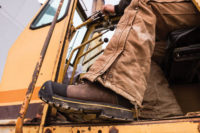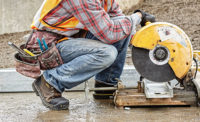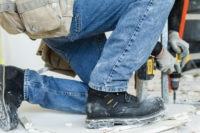The market is full of manufacturers introducing new boots, proprietary technologies and the latest and greatest additions to the art of safety footwear. However, understanding what you need and knowing the terminologies to navigate this sea of work boots will help you to better find what will hopefully be your favorite pair of boots. After all, comfortable feet make the work day easier and let you focus on the real job at hand.
Know your needs
Understanding the various safety features in work boots is paramount to finding the right boot for your needs. Always start with your safety manager, foreman or HR manager to determine if there are specific safety-gear requirements for your specific job or project.
OSHA enforces guidelines for occupational foot protection based on requirements established by the American National Standards Institute (ANSI). These guidelines help to ensure that skilled craftsmen and laborers wear the right protection when exposed to jobsite hazards including electric, falling objects, slippery surfaces and much more. Review requirements with your company or employer and select footwear that meets these needs. Today’s footwear manufactures do a great job of creating footwear that is ANSI compliant, but knowing what you need ahead of time will save time and effort.
Before you venture to the store, it’s important to know what you’re looking for. That starts with understanding safety and technology within footwear.
Safety toes
The environment of a craftsman or industrial employee is often wrought with heavy hazards. Finding the right protective toe is, in part, preference. There are three types of protective toes: steel, composite and aluminum. All three toes can be ASTM-rated similarly for protection. Oftentimes workers will select a specific safety toe based on their working environment and needs.
Steel Toes: Steel toes are the traditional choice for protective toe caps and are heaviest and most compact. While your feet aren’t exposed to the steel insert, steel toes can conduct temperature more than alternative safety options. Footwear manufactures today have begun devising ways to improve fit and comfort of steel toes by using protective toe-caps designed for the fit and size of the boot.
Aluminum Toes: Aluminum toes offer another choice for lightweight protection while still meeting ANSI/ASTM safety standards. They are the thicker than steel toes and provide a great option for workers looking for the most lightweight choice in footwear.
Composite Toes: Composite toes are typically comprised of carbon fiber, plastic or Kevlar. They comply with ANSI/ASTM safety requirements and are lighter than steel toes but are the thickest option for a safety toe and therefore have a bulkier silhouette than their steel or aluminum counterparts. Composite toes do not transfer cold or heat and, since they are non-metallic, offer a great safety option for workers passing through metal detectors or working in an environment that needs to stay metal-free.
Metatarsal guards
Work boots with metatarsal guards help to protect the upper foot and toe area from heavy falling objects. This additional protection is also advantageous for welders or those working in environments where falling embers or hot materials may be a concern.
Protection taken to the next level
Many products on the market today take protection to the next level in footwear. Tough-Tec leather provides increased abrasion-resistance and is often added to the boot’s upper to provide further protection to the upper and foot. For those craftsmen working near open flames, Kevlar fibers have wonderful applications for fire-resistance. Some manufactures utilize special Kevlar laces for firefighting and welding wear that won’t melt when heat is applied, like their nylon counterparts.
Soles
A number of durable materials on the market create outsoles that are long-wearing, slip-resistant and protective. While some industries may require a specific material, having an understanding of the options will help you make a more informed decision.
Rubber Outsole: This catchall term refers to the bottom of the boot; however, understanding its materials and their functions is paramount. Rubber is a common outsole component and is typically abrasion-, oil- and slip-resistant — important features for work in construction or manufacturing settings. Vibram®, a high performance rubber and an excellent choice for worksites with rugged terrains, provides maximum traction on both wet and dry surfaces. Today’s manufacturers often have their own proprietary rubbers, allowing their outsoles to have additional performance or safety attributes.
TPU Outsole: Outsoles made from Thermo Poly Urethane are long-wearing and are abrasion-, oil- and chemical-resistant. Designed to be tough, they typically resist splitting, and are more lightweight than their rubber counterparts.
EVA Midsole: A boot’s midsole is designed to disperse weight or provide stability for the foot. An EVA midsole, short for ethylene vinyl acetate, is a foam-like material that is lightweight, flexible and cushions the foot with each step
Construction applies to feet as well
How a boot is constructed can be directly related to weight, flexibility and performance. Today’s footwear brands are continually innovating construction methods to improve durability and comfort for the wearer. Some constructions include:
Cement Construction: Cement construction refers to the boot’s sole and is cemented directly to the upper. This construction is lightweight and flexible but could result in de-lamination over time. Cement constructed boots cannot be re-soled.
Goodyear® Welt Construction: Goodyear® Welt Construction provides durability for footwear as the upper and inner sole is stitched together with a leather strip or ‘welt’. The sole is then stitched through the welt. This process allows boots to be re-soled or repaired, thus extending the longevity of the footwear.
Industry Innovations: Today’s footwear manufacturers are always challenging themselves to find the next best way to create safety footwear. You see brands innovating welt construction to improve flexibility, durability and even appearance.
Fit matters
At the end of the work day your feet should not be rubbed raw, squeezed tight or sore with blisters and abrasions. Too-tight shoes can lead to a variety of foot ailments including in-grown toe nails, blisters, corns or worse. Additionally, the wrong fit may cause discomfort in the toe box from the safety toe cap. A leather boot will stretch somewhat as it conforms to the shape of your foot; however, a steel toe will never stretch, so never purchase a pair of safety-toe boots with the idea that they will eventually break in and stretch out. Finding the right size boot is very important for all-day comfort. When trying on a boot, if it feels too snug, don’t be afraid to move to a wide width.
Buying 101
Below are some simple tips to remember when shopping for your next pair of work boots:
◦ Do your research first. Find out what requirements you might have in your work environment and what personal needs you may have.
◦ Shop for boots in the afternoon or early evening. Feet tend to swell throughout the day, especially for those on their feet. By trying on footwear when your feet are at their largest, your work boots will feel comfortable even on the longest days.
◦ Come prepared. Bring a typical pair of socks that you might wear to better understand how your boots might fit.
◦ Don’t forget about comfort. Brands today incorporate so many comfort features to partner with their performance and protection enhancements. Anti-microbial insoles; lighter, more asymmetrical steel-toes; additional padding and other modern comfort features all go into making a pair of boots that will still feel as comfortable when you take them off as when you put them on.
◦ Don’t forget your homework. Yes, the job doesn’t end when you punch out. After-care for your footwear provides a longer life for your boots. Treat leather with mink oil or leather treatments to keep materials supple and resistant to water. Store your boots in a clean, dry place to reduce odors and preserve the leather.



